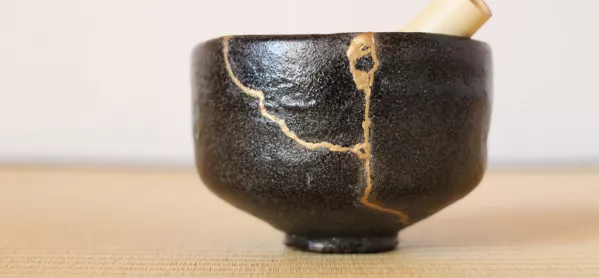- Home
- How the Japanese art of kintsugi can defy perfectionism
How the Japanese art of kintsugi can defy perfectionism

There’s been a steadily rising tide of perfectionism over the past 25 years, and young people are drowning in it.
That’s the key finding of one of the largest-ever studies on perfectionism, carried out last year.
One of the most likely reasons for this increase is something called “competitive individualism”.
It’s the idea that the person who works the hardest, self-promotes the strongest, and makes the smartest choices, will be top of the pile.
It’s the essence of The American Dream - but it’s no longer only American.
Learning from your mistakes
In this context, showing any cracks or imperfections is anathema. In fact, letting it be known that you’ve ever been less than perfect is dangerous.
Because if you do, and you’re competing against someone who is flawless, then you’re going to come in second.
In school, teachers will recognise this in students who are hypercritical of themselves, and often of others around them.
The student who procrastinates and is afraid of handing in an essay because, if it isn’t perfect first time, they will react very badly - they will not only get upset about what they’ve done but feel shame about who they are.
Not only that but they often convince themselves that, if their imperfections are found out, people will stop liking them.
In the social sphere, it’s the student who carefully selects and filters images to present a “perfect” online profile, raising the stakes of perfect body-image for everyone.
Professor Simon Sherry, of Dalhousie University in Canada, puts it this way: “Perfectionism is a myth and social media is its storyteller.”
The evils of perfectionism
But these surface manifestations are often just that: a reflection of deeper concerns about feeling broken because of experiences of heartbreak, self-doubt, loss, cruelty, failure, illness - in short, life.
So, it’s not hard to see how quickly all of this leads to anxiety and depression.
But there’s an ancient Japanese art which, at its heart, not only helps people to accept their own brokenness and imperfections but actually to celebrate it.
It’s called kintsugi, and its story started in the 15th century when a young man called Ashikaga Yoshimasa dropped and smashed one of his favourite bowls.
Rather than throw it away, he sent this bowl to be mended. But when it was returned, it had ugly metal staples along the cracks, holding it together.
This bowl meant a great deal to Yoshimasa and he felt that it demanded more respect than this, so he commissioned the finest artists and craftsmen of the time to develop a more thoughtful process of repair.
Eventually, this led to the art of kintsugi, which literally means gold-joining. It’s the practice of mending ceramics with lacquer resin and powdered gold.
Embracing cracks and damages
Rather than covering up cracks and imperfections, Kintsugi seeks to emphasise and celebrate them with the gold paint of the resin that binds the broken pieces together.
It’s a recognition that these cracks are part of the story of a piece of pottery, making it unique and beautiful. It is about showing that it is something worth repairing.
And you can use this process to think about helping perfectionists or anyone who feels shame because of their brokenness.
For example, the first step of kintsugi is to pick up the broken pieces and soften any sharp edges. When we’re in pieces, the sharp edges hurt.
So, the first step is to acknowledge and accept that we’re broken, and to be careful with the sharp edges, to soften them by talking to someone about them and seeking help.
Next is to put the pieces back together.
In kintsugi, this requires great patience - working out how to fit the pieces back together, and holding the pieces in place carefully while the resin dries. Similarly, piecing ourselves back together will not be a quick process.
But, when the resin does dry on a piece of pottery, it doesn’t bring it back to its former strength, it makes it even stronger.
And perhaps most importantly, kintsugi involves allowing the imperfections, and the mending, to be seen.
In fact, not just seen but highlighted in gold.
Strength in failure
This idea can help people to understand that, when you allow your imperfections and your healing to be seen - like the gold paint in kintsugi - you are not revealing weakness but highlighting strength.
You’re showing the world that here is a person brave enough to have engaged fully with life and display the scars that were picked up along the way.
Perhaps even more importantly, you’re showing that here is a person who has been broken, but who is precious enough to be put back together with great care.
Aidan Harvey-Craig is a psychology teacher and student counsellor at an international school in Malawi. His book, 18 Wellbeing Hacks for Students, is out in August. He tweets @psychologyhack
Keep reading for just £1 per month
You've reached your limit of free articles this month. Subscribe for £1 per month for three months and get:
- Unlimited access to all Tes magazine content
- Exclusive subscriber-only stories
- Award-winning email newsletters



